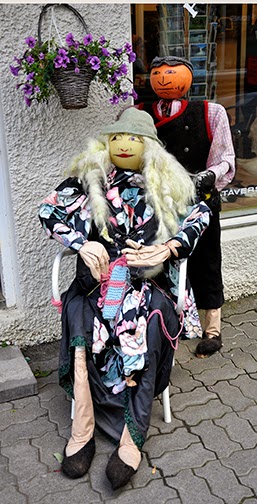WATERFALL OF THE GODS.
 Goðafoss is a spectacular set of waterfalls in central north Iceland. It is not the largest Icelandic waterfall but it is very pretty and historically significant.
Goðafoss is a spectacular set of waterfalls in central north Iceland. It is not the largest Icelandic waterfall but it is very pretty and historically significant.
Our aim that day was Husavik - but the falls were just about half way in between ... a little detour from the ring road # 1.
We were surprised to see the fields of ripening wheat and stands of planted trees - someone trying to forest the barren landscape of Iceland.
Surprised? We shoud not have been!
 With the tectonic plates drifting away from each other thus ripping Iceland into two this area is, once again, rich in geothermal energy.
With the tectonic plates drifting away from each other thus ripping Iceland into two this area is, once again, rich in geothermal energy.
That's why we see many greenhouses and fertile fields.
 To make it all more interesting a river Skjálfandafljót (you pronounce it if you can) has made its way all the way from the ice caps of the mighty Vatnajökull, the largest glacier in Iceland.
To make it all more interesting a river Skjálfandafljót (you pronounce it if you can) has made its way all the way from the ice caps of the mighty Vatnajökull, the largest glacier in Iceland.
Oh yes, this river is on its South to North course conquering the interior highlands before reaching the Greenland Sea.
Skjálfandafljót is known for its waterfalls one of which is Goðafoss - Waterfall of the Gods.
About 30 meters wide and 12 meters high they are far from the largest but their significance is in their role in the history of Iceland.
The year 1,000 found Iceland without a unifying religion - there were tribes and families worshiping different deities from different corners of the Viking world. There was also Christianity making its way here from the South.
We all know too well about the struggles amongst religions and beliefs and the wars in name of religions.
To avoid such fight the emerging nation decided to choose one official religion that would represent it and its values. Easy to say - but which one?
Here we can reconnect with one of the previous entries in this blog - that of the Þingvellir and the first parliament. There, at the annual convention, Alþingi, attended by ll the Icelanders, the governing body of wise men chose ONE person - the country's law speaker to make the hard decision.
"What are we going to be?"
He, himself a pagan, pondered for a very long time. At the end he chose Christianity - for what reasons, political or otherwise, we do not know.
 After the convention at Þingvellir the law-speaker made his way back north to his home-farm. As he passed the falls on Skjálfandafljót River, he unwrapped the statues of his pagan gods and tossed them into the falls.
After the convention at Þingvellir the law-speaker made his way back north to his home-farm. As he passed the falls on Skjálfandafljót River, he unwrapped the statues of his pagan gods and tossed them into the falls.Godafoss were born.


The sun is hugging the horizon and it is time to continue to Husavik. One last look, a good-bye to the river with an unpronounceable name and we are heading North - all the way to the coast.








































